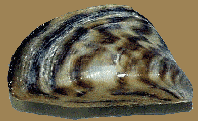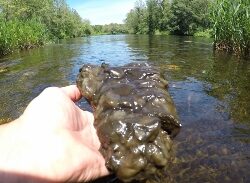Aquatic Nuisances

Northern Snakehead – Channa argus
One of the most common disturbances seen today in aquatic environments is aquatic nuisance species. An aquatic nuisance species is an undesired non-native species to the particular waterway whose introduction causes, or is likely to cause, economic or environmental harm or harm to human health. Aquatic nuisance species can be animals, plants, or even microbes.
It is important to note that not all non-native species are considered invasive. Some species have been purposely introduced to, and thrive in, highly altered habitats where native species cannot exist, or for purposes such as development of economically important fishing opportunities, and control of other non-native species.
Although many people may think one small fish released into a river may not have an impact, aquatic nuisance species create huge problems for other fish, ecosystems, property, water clarity, game fish populations, boating equipment, and infrastructure. Aquatic nuisance species will often out-compete other fish for both food and shelter, effectively decimating entire populations of game fish. Aquatic nuisance fish can also prey directly on game fish populations, completely disrupting the balance of aquatic ecosystems.
Where Can They Be Found?

Zebra Mussel – Dreissena polymorpha
Aquatic nuisance fish species can be found all over the U.S. and can wreak havoc on local populations of fish found in ponds, lakes, streams, bays and oceans. Because recreational anglers may unintentionally transport unwanted species into ponds and lakes or from the area where they were just fishing, we may be the biggest culprits and don’t even know it. Many aquatic nuisance species are hitchhikers that will attach themselves to boats, fishing tackle, nets, ropes, buckets and other equipment completely undetected. When these items are used during the next fishing trip, anglers unknowingly transport species to new areas and bodies of water.

Rock snot image courtesy of CT DEEP
Another major cause for the spread of aquatic nuisance species is the intentional release of certain fish species into waterways. This is a particular problem for fish species that may have been kept in an aquarium. Rather than properly removing the fish from an aquarium or moving it to a bigger aquarium, many people will release their fish into local waterways or even storm drains. Unfortunately, many of these released species survive quite well and eventually reproduce. If reproduction continues, this introduced species of fish upsets the balance of other native fish species.
What You Can Do To Help
To ensure that you’re not contributing to the problem of aquatic nuisance species in our waterways, there are a few simple steps to follow to minimize or eliminate your impact:
- Never release a fish into a new body of water. If you caught a fish that you plan on releasing, be sure to release it into the same body of water where it was caught. This includes any live bait.
- Always remove any and all visible plants, mud, dirt, fish, and any gear from your boat. This includes fishing tackle, ropes, anchor lines, engines, trailer, and anything else that may have been used around water. Ideally, a quick spray of your equipment with a hose before leaving the boat ramp is the best option. If you have to wait until you get home, rinsing off there is also a much better option than dropping the boat into another lake or pond without being sprayed. If you have to clean your equipment at home, try to make sure that the water isn’t draining into a storm drain. This can lead to the introduction of invasive species to a nearby waterway.
- If you catch your own bait, always be sure to clean your bait nets before putting them away for the next use. If you know your net has been in waters where zebra mussels or other nuisance shellfish species are found, a quick spray or dip into a vinegar solution will kill off any shellfish larvae.
- Always try to empty any bilge water at the boat ramp. This will eliminate the chance of transporting harmful species that may have hitched a ride in the bilge of your boat. Also remove any drain plugs from the boat so that water can escape the hull of the boat before being launched in a new location.
- Try to avoid driving your boat through large areas of aquatic vegetation. Not only could this damage your engine, you could also inadvertently pick up invasive vegetation which can lay dormant for weeks at a time.
Aquatic Nuisances

Northern Snakehead – Channa argus
One of the most common disturbances seen today in aquatic environments is aquatic nuisance species. An aquatic nuisance species is an undesired non-native species to the particular waterway whose introduction causes, or is likely to cause, economic or environmental harm or harm to human health. Aquatic nuisance species can be animals, plants, or even microbes.
It is important to note that not all non-native species are considered invasive. Some species have been purposely introduced to, and thrive in, highly altered habitats where native species cannot exist, or for purposes such as development of economically important fishing opportunities, and control of other non-native species.
Although many people may think one small fish released into a river may not have an impact, aquatic nuisance species create huge problems for other fish, ecosystems, property, water clarity, game fish populations, boating equipment, and infrastructure. Aquatic nuisance species will often out-compete other fish for both food and shelter, effectively decimating entire populations of game fish. Aquatic nuisance fish can also prey directly on game fish populations, completely disrupting the balance of aquatic ecosystems.
Where Can They Be Found?

Zebra Mussel – Dreissena polymorpha
Aquatic nuisance fish species can be found all over the U.S. and can wreak havoc on local populations of fish found in ponds, lakes, streams, bays and oceans. Because recreational anglers may unintentionally transport unwanted species into ponds and lakes or from the area where they were just fishing, we may be the biggest culprits and don’t even know it. Many aquatic nuisance species are hitchhikers that will attach themselves to boats, fishing tackle, nets, ropes, buckets and other equipment completely undetected. When these items are used during the next fishing trip, anglers unknowingly transport species to new areas and bodies of water.

Rock snot image courtesy of CT DEEP
Another major cause for the spread of aquatic nuisance species is the intentional release of certain fish species into waterways. This is a particular problem for fish species that may have been kept in an aquarium. Rather than properly removing the fish from an aquarium or moving it to a bigger aquarium, many people will release their fish into local waterways or even storm drains. Unfortunately, many of these released species survive quite well and eventually reproduce. If reproduction continues, this introduced species of fish upsets the balance of other native fish species.
What You Can Do To Help
To ensure that you’re not contributing to the problem of aquatic nuisance species in our waterways, there are a few simple steps to follow to minimize or eliminate your impact:
- Never release a fish into a new body of water. If you caught a fish that you plan on releasing, be sure to release it into the same body of water where it was caught. This includes any live bait.
- Always remove any and all visible plants, mud, dirt, fish, and any gear from your boat. This includes fishing tackle, ropes, anchor lines, engines, trailer, and anything else that may have been used around water. Ideally, a quick spray of your equipment with a hose before leaving the boat ramp is the best option. If you have to wait until you get home, rinsing off there is also a much better option than dropping the boat into another lake or pond without being sprayed. If you have to clean your equipment at home, try to make sure that the water isn’t draining into a storm drain. This can lead to the introduction of invasive species to a nearby waterway.
- If you catch your own bait, always be sure to clean your bait nets before putting them away for the next use. If you know your net has been in waters where zebra mussels or other nuisance shellfish species are found, a quick spray or dip into a vinegar solution will kill off any shellfish larvae.
- Always try to empty any bilge water at the boat ramp. This will eliminate the chance of transporting harmful species that may have hitched a ride in the bilge of your boat. Also remove any drain plugs from the boat so that water can escape the hull of the boat before being launched in a new location.
- Try to avoid driving your boat through large areas of aquatic vegetation. Not only could this damage your engine, you could also inadvertently pick up invasive vegetation which can lay dormant for weeks at a time.



